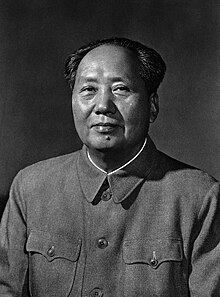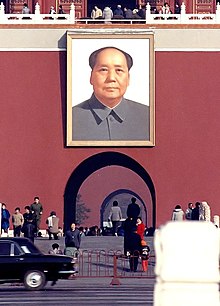Mao Zedong
Mao Zedong | |
|---|---|
 Official Portrait, 1959 | |
| Chairman of the Communist Party of China | |
| In office 20 March 1943 – 9 September 1976 | |
| Preceded by | Zhang Wentian (as General Secretary) |
| Succeeded by | Hua Guofeng |
| President of the People's Republic of China | |
| In office 1 October 1949 – 27 April 1959 | |
| Preceded by | Post Established Chiang Kai-Shek as President of Republic of China |
| Succeeded by | Liu Shaoqi |
| Personal details | |
| Nationality | Chinese |
| Political party | Communist Party of China |
| Signature |  |
Mao Zedong (26 December 1893 – 9 September 1976) was a Chinese Communist leader. He is notable for the resistance of the Japanese invasion and unifying China, which he ruled as the chairman of the Communist Party of China.
Name[change | change source]
Mao Zedong is the Latin-alphabet version of Mao's name now used by most people. In the romanization common in his lifetime, it was spelled "Mao Tse-tung".[1] "Mao" is his family name - in China, family names are placed first. Mao is also called Chairman Mao, because he was the Chairman of the Chinese Communist Party.
Early life and career[change | change source]

Mao Zedong was born into a loving family on December 26, 1893 in the small village of Shaoshan in the Hunan province. After finishing school, He worked as a librarian were, he was exposed to Marxist literature. In 1921, he founded the Chinese Communist Party.
In 1927 KMT members purged members of the Communist Party in Shanghai, thus starting the Chinese Civil War, which Lasted from 1927 to 1949. During the the Japanese invasion of China during World War II, Mao formed an alliance and cooperated with the KMT against the Japanese.
After Japan's surrender in 1945, Mao fought against the KMT in early 1946. In 1949, Mao's forces successfully defeated the KMT, establishing the People's Republic of China, and unifying China as a single country.
Ruler[change | change source]


In the 1950s, Mao Zedong had many plans for how China could move forward in technology very quickly and catch up with countries like the United Kingdom and United States. Mao was responsible for the Five Year Plan. The Second Five Year Plan included the Great Leap Forward, which was a disaster for the Chinese people. Poor farming practices led to significant crop failure, and cities did not make many of their daily items like clothes and machines. The famine that came as a result killed millions of people via starvation. In the aftermath of the Great Leap Forward, Mao launched the Cultural Revolution in 1966 in order to keep his power and position within the Chinese Communist Party. The Cultural Revolution lasted for a decade until Mao's Death in 1976.
A few years after Mao won the civil war in China, Nikita Khrushchev became the leader in the Soviet Union. Before this, Joseph Stalin was the leader in the Soviet Union. Mao liked Stalin and respected the way he led. China and the Soviet Union became allies with each other. Khrushchev thought Stalin was a criminal dictator, and led the country very differently. Mao and Khrushchev did not like each other, so the Soviet Union was no longer allies with China. China now had only a few allies like Albania, North Korea, Democratic Kampuchea, and Pakistan. This change of friends was called the Sino-Soviet split. "Sino" is another way to say "Chinese".
During the 1970s, Mao became more friendly with the United States. In 1972, American president Richard Nixon visited the People's Republic of China and met Mao. Mao died in September 1976, and the Cultural Revolution also ended that year. Mao's supporters were imprisoned, and Deng Xiaoping, who followed Mao, revised Mao's economic policies.
Liu Shaoqi[change | change source]
Mao Zedong was afraid that Liu Shaoqi would overthrow him, and take over the CPC. As in the result, Mao blamed Liu Shaoqi for being a capitalist, and placed him in jail. Liu Shaoqi died in prison from brutal treatment, hunger, and terrible conditions.
Lin Biao[change | change source]
After Liu had been removed from leadership, the defence minister Lin Biao was ranked second in the party and hoped to succeed Mao. In 1971, Lin Biao and his wife died in a plane crash after trying to assassinate Mao and seize power for himself.
Death[change | change source]
Mao had been in poor health for several years and had declined visibly for at least six months prior to his death. There are unconfirmed reports that he possibly had ALS or Lou Gehrig's disease. Mao's last public appearance was on 27 May 1976,[2] where he met the visiting Pakistani Prime Minister Zulfikar Ali Bhutto during the latter's one-day visit to Beijing.
At around 5:00PM on 2 September 1976, Mao suffered a heart attack, far more severe than his previous two and affecting a much larger area of his heart. Three days later, on 5 September, Mao's condition was still critical. On the afternoon of 7 September, Mao's condition completely deteriorated. Mao's organs failed quickly and he fell into a coma shortly before noon where he was put on life support machines. He was taken off life support over 12 hours later, quarter to midnight and was pronounced dead at 12:08 am on 9 September 1976.
His body lay in state at the Great Hall of the People. There was a three-minute silence observed during this service. His body was later placed into the Mausoleum of Mao Zedong, despite his wishes to be cremated and he had been one of the first high-ranking officials to sign the "Proposal that all Central Leaders be Cremated after Death" in November 1956.[3]
Legacy[change | change source]

Many Chinese mainlanders still believe Mao Zedong was a great leader, but they also know that he did unwise and bad things. According to Deng Xiaoping, Mao was "seven parts right and three parts wrong" and his "contributions are primary and his mistakes secondary". Supporters praise him for having unified China and for ending the previous decades of civil war. He is also praised for having improved the status of women in China and for improving literacy and education. Some people think Mao Zedong made China lose its most important ally, or friend, the Soviet Union, in the Sino-Soviet Split. The Great Leap Forward and the Cultural Revolution were two of the things that Mao did that many people disliked.
Some historians think that tens of millions of people died because of Mao's bad ideas and neglect. Some people dislike Mao because he did not support family planning, and this caused too many births, so causing rapid population growth. Leaders of China after Mao passed a law called the one child policy. This had the long-term effect of greatly reducing the population.
Mao Zedong also made several changes to the Chinese language, such as switching from the Wade-Giles system of Romanization to Pinyin. For this reason, Nanking is now called Nanjing on modern maps. Taiwan still uses Wade-Giles, so its capital is called Taipei instead of the pinyin Taibei. Mao also simplified the Chinese characters. In theory it would make them easier to read and write so that more people would be literate.
References[change | change source]
- ↑ "Mao Zedong". Encyclopaedia Britannica. Retrieved 13 July 2016.
- ↑ "Last public appearance of Chinese leader Mao Zedong, 1976". 29 December 2016.
- ↑ Hays, Jeffrey. "MAO'S DEATH, LEGACY AND DESCENDANTS - Facts and Details". factsanddetails.com.
Sources and other websites[change | change source]
- [1] Archived 2006-08-28 at the Wayback Machine Washington State University.
- BBC 中国丛谈特辑(上)
- BBC 中国丛谈特辑(上)采访录音
- BBC 中国丛谈特辑(下)
- BBC 中国丛谈特辑(下)采访录音
- 開放出版社 《毛澤東:鮮為人知的故事》中文版 Archived 2006-10-29 at the Wayback Machine
- 《毛澤東:鮮為人知的故事》 英文注釋 Archived 2007-01-27 at the Wayback Machine
- 德国之声,含采访录音 张戎:鲜为人知的毛泽东是怎样写成的
- Spence. J. MAO 1999 Weidenfeld & Nicolson LONDON
- Wikipedia - Liou Shaoqi, last heading
- Becker, Jasper. Hungry Ghosts. New York: The Free Press, 1996. Print.
- Mao Zedong -Citizendium
- Peter Polack, Guerrilla Warfare; Kings of Revolution,Casemate, ISBN 9781612006758.
